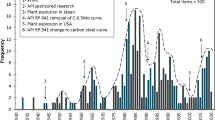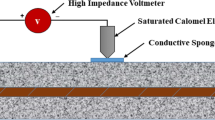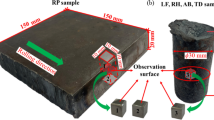Abstract
Cathodic protection has been applied for many years as the best method to prevent the corrosion in systems which transported hydrocarbon pipelines. However, it has found the presence of stress corrosion cracking (SCC) in steel pipelines with high concentrations of carbonates and bicarbonates with pH final (9 to 11). The resistance to the stress corrosion cracking of the API X-52 and API X-65 steels was evaluated on compact modified wedge opening specimens (WOL). The specimens were loaded of 95% of the yield strength. The resistance of crack propagation and the corrosion rate were evaluated with different applied potentials (-850 and -650 mV), this with respect to a saturated copper/copper sulfate reference electrode. The used electrolytes were simulated soils (carbonate-bicarbonate solution). Evidence of crack propagation of the API X-52 and API X-65 steels were carried out by scanning electron microscopy. The obtained result showed susceptibility to SCC on specimens with cathodic protection. The cathodic protection applied (-850 mV vs Cu/CuSO4 electrode) decreases considerably the corrosion rate on the evaluated steels. In this work the loaded stress showed to be a very important variable on the susceptibility to SCC.
Similar content being viewed by others
References
C.A.M. Ferreira, J.A.C. Ponciano, D. Santiago Vaitsman, D. Vidal Pérez, Science of the Total Environment 1, 250 (2007).
Ana Osella, Alicia Favetto, Journal of Applied Geophysics 44, 303 (2000).
D. Delafosse, T. Magnin, Engineering Fracture Mechanics 68, 693 (2001).
Parking R.W. Predictive approach to stress corrosion cracking. In: Gangloff RP, Ives MB, Editors. Environment induced cracking of metals, NACE, Houston Texas, 1990. p. 1
S.L. Asher, B.Leis, J.Colwell, and P.M, Singh, Corrosion Science 49, 932 (2007).
S.R. Novak and S.T. Rolfe, J. Mat. 4, 701 (1969).
W.F. Deans and C.E. Richards, J. Testing Eval. 7, 147 (1979).
T. Lu and J. Luo, Corrosion Science 44, 1695 (2002).
J.J. Perdomo, J.L. Morales and A. Viloria, A.J. Lusinchi, Materials Performance 41, 55 (2002).
J.F. Knott: Hydrogen Effects on Material Behavior, Conf. Proc., Moran. WY. 1990, N.R. Moody and A.W. Thompson, eds., TMS-ASME, Warrendale, PA, 1990, pp. 661–75.
P.J. Kentish, Corrosion 20, 139 (1985).
J.A. Beavers, C.E. Jaskece, CORROSION/98, NACE Inter, Houston, TX, 1998, Paper No. 304.
R.N Parkins, CORROSION/2000, NACE Inter, Houston, TX, 2000, Paper No. 363.
W.Chen, F. King, E. Vokes, Corrosion 58 (2002) 267.
Author information
Authors and Affiliations
Rights and permissions
About this article
Cite this article
García, R.M.L., Quintero-Torres, R. Characterization of the Crack Propagation in the API X-52 and API X-65 Steels into Cathodic Protection. MRS Online Proceedings Library 1242, 46 (2009). https://doi.org/10.1557/PROC-1242-S4-P46
Published:
DOI: https://doi.org/10.1557/PROC-1242-S4-P46




